#fern identification
Explore tagged Tumblr posts
Text

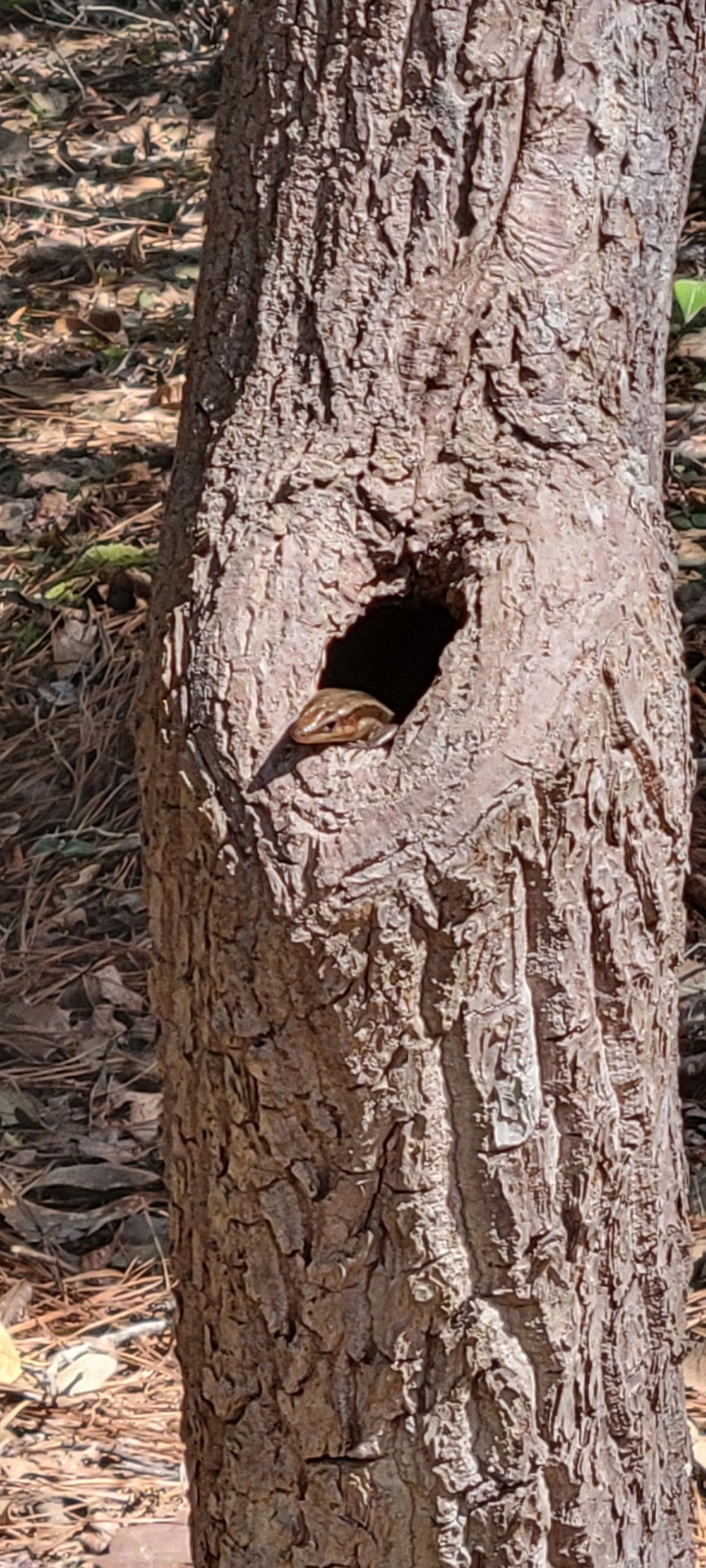

I got to go on my first birding field trip with my university's birding club this morning!
Notable sightings:
Blue headed vireo
Northern Parula (heard only)
This specific lil guy (Yellow-rumpedwarbler) with a POWER STANCE lol

picture is kinda ass bc its on my phone zoomed in like 20x but it makes it even funnier imo lollll
#naturalist#nature#bird identification#birding#escapism#explore#plantblr#plant photography#plant identification#hiking#nature hikes#state park#birds#birdwatching#field trip#yellow rumped warbler#fern#skink#frog
14 notes
·
View notes
Text
How to Identify Western Sword Ferns
Originally posted at my blog at https://rebeccalexa.com/how-to-identify-western-sword-ferns/. Click here to learn more about the How to Identify article series.
Name: Western sword fern (Polystichum munitum)
Range and typical habitat(s): West coast of North America from southern California to extreme southern Alaska, and inland to the western Rockies in Idaho; also introduced to a few places in the United Kingdom and Ireland. Widespread through conifer forests at low elevations; while it is most commonly part of the understory of these forests, it may sometimes be found in nearby open areas as an early succession pioneer after disturbance.

Distinguishing physical characteristics (size, colors, overall shapes, detail shapes): This is a large fern, with individual fronds up to six feet long; the entire plant may be six or more feet across in very large specimens. The overall shape of younger plants may be a sort of “fountain” formation; with age and size some of the stems begin to droop downward, giving the overall plant more of a spherical or semi-spherical appearance. The leaves are a medium to medium-dark green; the spore-bearing sori on the underside are a rusty brown.

Underside of leaves showing sori. By brewbooks, CCA-SA-2.0
Each frond consists of a single stem (rachis). This rachis is round, solid inside, and may have a deep furrow down the center. It is green with rust-brown flecks along its length. Individual leaves (pinnae) grow in an alternate pattern along the stem; alternate means that one grows on one side, and then the next on the other just a little further down the rachis, and then the next on the first side a little further down, etc.) Almost the entire rachis is covered in leaves, except for a few inches at the base. Several of these may grow out of the same root/rhizome system, clustered close together, with dead growth from previous years lying on the ground at the plant’s base.

The sword fern is what’s known as single pinnate, meaning that there are leaves arranged in pairs along a single rachis, but those leaves are not further divided into smaller leaflets. Each leaf is lance-shaped with a pointed tip and finely serrated edges. The leaf has a main central vein, with smaller veins branching off of it in pairs, one on each side. On the underside of the leaf, the sori look like little brown fuzzy circles. They are arranged quite closely to each other in two rows, one row on either side of the central vein of the leaf. Each leaf varies from less than an inch to six inches long; the larger leaves are closer to the base of the stem, and get smaller toward the tip. The last few leaves near the tip may not be fully separated from each other. The leaves are attached to the rachis by very slender, short stems (petioles) at their base. The tips of some of the leaves may point away from the center/base of the plant, toward the end of the rachis.
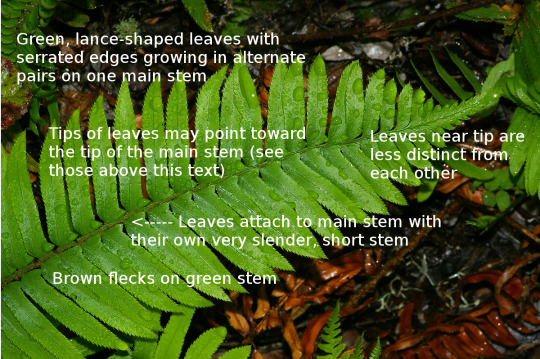
Other organisms it could be confused with and how to tell the difference: While western sword fern tends to be the most common Polystichum species in its range, there are a few other species of the genus that overlap. You’ll need to look at small details to tell the difference; for example, P. imbricans can be distinguished from P. munitum by examining the leaves in relation to the main stem. In P. imbricans, the leaves are actually rotated on their petioles so that they are perpendicular to the stem like rungs on a ladder, rather than growing “flat”:
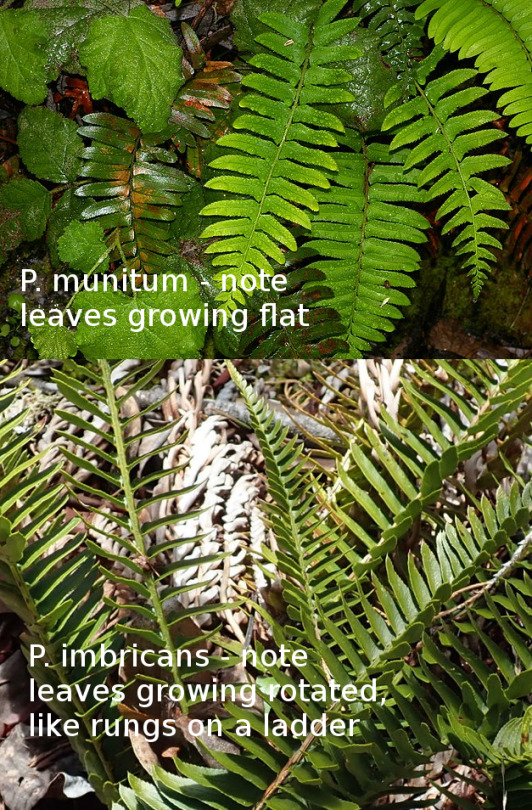
In addition to paying attention to small differences in things like leaf shape and arrangement, you also want to note where you saw the fern in question. Not every look-alike Polystichum species will be found in every part of western sword fern’s range; P. californicum, for example, only grows from southernmost British Columbia to central California. If you don’t have access to field guides, create a free account on iNaturalist. You can use the Explore function on the phone app or computer browser to see where people have logged observations of just about any species of living being you can think of; while it isn’t as exact as a formal range map, it’s a good substitute for casual use.
Finally, there are other ferns outside of the genus Polystichum that can also be confused with western sword fern. A good example is deer fern (Struthiopteris spicant). While it also has a cluster of individual fronds, each composed of a central rachis with pairs of leaves on either side, deer fern is smaller than western sword fern. A closer look shows that the leaves of deer fern are attached to the rachis by their entire bottom edge (sessile), rather than by a petiole:
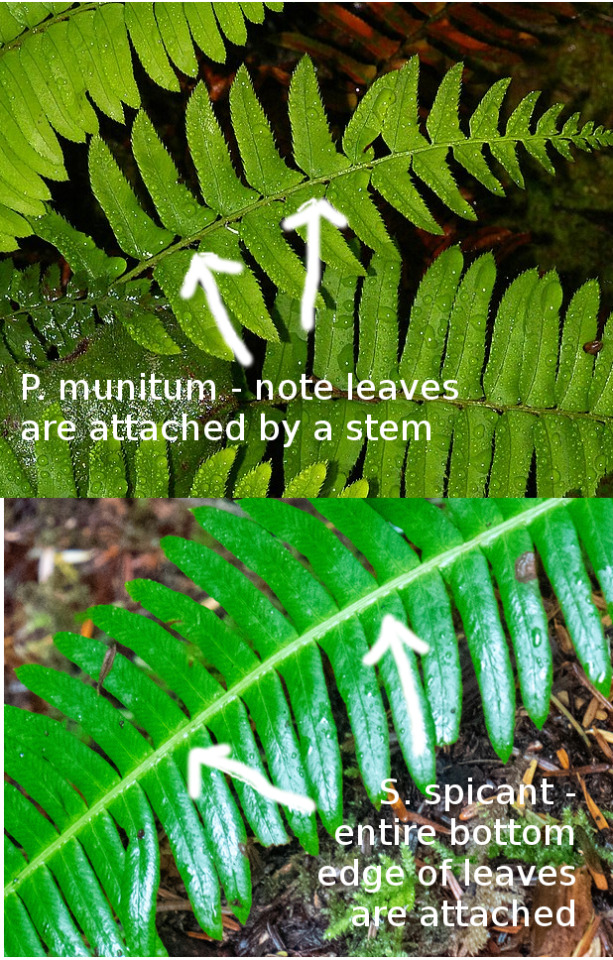
Also, deer ferns have specially adapted “fertile” leaves that look different from the rest; western sword ferns lack these. These consist of a dark, tall rachis that has thinner, more widely spaced leaves; these lift the sori higher above the rest of the plant so that the wind can more easily blow away the spores. Their resemblance to deer antlers gives this fern its name:

A good quick guide that may help with distinguishing western sword fern from others in its range is Pacific Fern Finder by Glenn Keator. While it isn’t absolutely complete, it covers the more common species and is a dichotomous key that helps you narrow down your options by looking at various physical characteristics of the fern you’re trying to identify.
Anything else worth mentioning? Western sword ferns are not among the few species whose fiddleheads (young, curled-up fronds) are safe to eat. Reportedly the rhizomes have historically been used as a last-resort food source by some indigenous people. However, concerns about carcinogens mean this plant should not be considered a regular edible.
10000 Things of the PNW has a more detailed write-up of this species here.
Further reading:
Native Plants PNW: Western Sword Fern
OSU Extension’s Tourism Blog: Western Sword Fern
CalScape: Sword Fern
10000 Things of the Northwest: Polystichum imbricans (as a comparison to P. munitum)
Did you enjoy this post? Consider taking one of my online foraging and natural history classes, checking out my other articles, or picking up a paperback or ebook I’ve written! You can even buy me a coffee here!
#ferns#nature#PNW#Pacific Northwest#plants#botany#biology#forest#forestcore#naturecore#ecology#nature identification#How to Identify#long post#foraging#educational#outdoors#natural history#scicomm#science communication
133 notes
·
View notes
Text

If any plant nerds care, the plant in ofmd they steal in the pilot from those fishermen is a Brazilian tree fern. I used my plant identification app so yeah. I’ll have to wait for the episode where it was healthy again to confirm.
Update: it is. Olu holds it up later and it’s definitely a healthy fern plant 🥰
Meaning: endurance, personal growth, symbol of resilience and adaptability. Eternal youth and love. Renewal and rebirth. Humility and sincerity in Victorian times.
Medicinal properties: wash/poultice for bleeding, vomiting, lung damage, blood disorders, treatment of skin, kidney and eye infections, treatments for cancer and diabetes. The sugars can be used in de-aging skin to tone and tighten it before softening it. Treatment of tuberculosis as a cough medicine, chills, lung hemorrhaging, sore throats, colds, measles and congestion. Effectively removes ARSENIC from soil, but also airborne pollutants like formaldehyde, xylene and toluene which can cause headaches. An anti rheumatic, febrifuge, gynecological aid, gastrointestinal medication. Supports mental wellbeing. Treatment of bacterial skin infections, kidney diseases, varicose veins.
In cooking: fiddleheads, fronds and rhizomes are edible; used in Asian and Native American dishes. Fronds used to line baskets for food boxes, storage boxes, berry baskets, drying racks, earth ovens and steaming pits. Used in teas and poultices.
#plants#Brazilian tree fern#ferns#ofmd#plant identification#gardening#info dump#mine#q are everybody
2 notes
·
View notes
Text





Digitalis purpurea -common foxglove is such a beautiful plant+ some beautiful ferns and trees and other plants in the pic
#plants#botanist#botany#flowers#floral#foxglove#forestcore#forest#horticulture#ferns#trees#plant identification#scottish#scotland#plantblr
3 notes
·
View notes
Text


some plants :)
I found them on a castle wall by loch ness; does anyone know what they might be?
5 notes
·
View notes
Text


Local Christmas fern growing on a steep hillside.
2 notes
·
View notes
Text
PLANT PEOPLE PLEASE HELP!!!


who is she
#i cant tell if it’s actually a fern or not i found it growing on its own in me lawn (in virginia)#i am. bad at plants#plant identification#plantblr#plant id
5 notes
·
View notes
Video
n196_w1150 by Biodiversity Heritage Library Via Flickr: Flora Graeca, sive, Plantarum rariorum historia, quas in provinciis aut insulis Graeciae / Londini :Typis Richardi Taylor et socii, in Vico Shoe-Lane :MDCCCVI-MDCCCXL [1806-1840]. biodiversitylibrary.org/page/54121352
#Greece#Identification#Mediterranean Region#Pictorial works#Plants#Lloyd Library and Museum#bhl:page=54121352#dc:identifier=https://biodiversitylibrary.org/page/54121352#Cheilanthes suaveolens#Hemionitis pteridioides#Oeosporangium pteridioides#fern#ferns#flickr#botanical illustration#scientific illustration
0 notes
Text


Need some plant id, plan to weed this area and if these are sunflowers they could be good to leave for the animals. However there may be plenty of other thick stemmed plants in New York or other horticultural plants that may have been spread here
#plant identification#what is this plant#plz help#gardening#the ferns will be left alone#maybe trampled a little during the weeding#but they’re durable plants
0 notes
Text








Little summer river hike, taking lots of photos
#hike#hiking#plant#plants#iris#yellow iris#fern#skunk cabbage#rhododendron#deer tongue#pinxter flower#plant identification#plant id#nature
1 note
·
View note
Text
First Time on The Land
It is an eight hour drive to the Land, and I’m anxious the entire way. I’ve never liked meeting new people, and I’m terrified that my wife and I had wasted a ton of money on what would inevitably be a miserable experience.
But when we arrive at the gate, my anxiety is thwarted by a parade of helpful womyn who guide us through the check-in process. I drive through the Land at 5 miles per hour, and wherever we look, there are womyn. They're busy unpacking or talking to one another, but when a car comes by they all wave and smile, shouting "welcome home!" The Land itself is beautiful, a pristine forest with a blanket of ferns covering the ground. Everything is green except the asphalt walking path that shimmers with leftover rain. As we get further in, tents pop up everywhere, nestled side by side. Plastic flowers are staked into the ground, and clotheslines strung between the trees bear Pride flags and handmade tapestries that flutter in the breeze. All of this is woven so seamlessly into the natural forest that I can’t quite believe it’s temporary.
There is an opening ceremony before the first concert. A womyn stands onstage and sings, and hundreds of womyn join her. “I am open, and I am willing, for to be hopeless would seem so strange. It dishonors those who go before us, so lift me up to the winds of change.” I am already crying and I know if I lift my voice with them that I will sob, so I keep my head down.. I’m not ready to be open.
The next day we wake up to a choir of women singing in the morning chant circle, and BMG starts in earnest. Womyn of all backgrounds volunteer to share their knowledge in participant-led workshops on writing, poetry, drumming, quilting, whaling, massage, salsa dancing, indigo dyeing, lesbian history, Nordic runes, plant identification, body painting, detransition, butch identity, and more. There is an archery range, a movie tent, and a large vendor space where womyn sell their wares. Shuttles driven by volunteers trundle up and down the dirt path, ferrying womyn across the land. The days pass in a flurry of activity, both of us exhausted but unwilling to rest. We try to do everything, much to the amusement of the older lesbians watching. They know what we don’t, which is that being here is enough of an event by itself, and the conversations we’ll have before and after these workshops are as valuable as the workshops themselves.
I’m continuously stunned by the generosity on display. One womyn cooks breakfast for two hundred, and another makes lunch the next day. We overhear a womyn give a stranger her spare air mattress. My wife tells me she has a headache and a passerby gives her an electrolyte packet and an apple. A woman offers me a comically huge blunt during a night concert, and another shows me where she stores her food when I compliment her ciabatta. Everywhere we go, womyn stop to talk. In workshops, I stand up (tits out!) and speak my mind, and womyn listen. I smile at everyone and say “good morning” to whoever I pass. And at some point I notice... I’m not anxious. I’m talking to strangers all day and it feels wonderful.
At the closing ceremony a womyn sings to us again, and everyone joins her. “I am open, and I am willing…” This time, I’m able to join in on the second chorus.
Sunday is bittersweet. My wife and I wake up early and cry into our oatmeal. We decide to take a walk before going back to our tent, unable to face packing up. I could sense the fear - absent for five glorious days - waiting for me outside the gates. Once we’re all cried out, practicality takes over and we pack our things, load the car, and head out.
Two womyn stop us at the gate.
“Are y’all coming back next year?” one asks. We say yes.
“Good, because I know your faces now!"
The other pipes up, “Faces? I’m going by breasts!”
The knot in my chest loosens as I laugh, and we drive home.
We have our wristbands, our sunburns, and a new labrys necklace. We carry a warmth, a brightness, in our chests. But a few days in, the feeling disappears and I can feel my walls going up again. That unconscious tension in my gut. A week after re-entry, my bruise from archery fades, and with it the feeling of being on the Land that I could once call up so easily just by taking an extra-hot shower, or a long walk outside. Now as I write this, I can hardly remember the person I was this summer. She’s waiting inside me to make her appearance again.
There are times I feel her stirring: when I connect with other womyn like me. When I feel grounded and at peace with myself. And sometimes I can feel her revolting when I try to duck back under the yoke of other people’s expectations. I’ve seen what life can be like without that now, and I can never really go back. It feels like there will always be a part of me waiting under the trees.
Thank you @nansheonearth for challenging me to write about my experience on the Land, and for helping me find it in the first place.
71 notes
·
View notes
Text
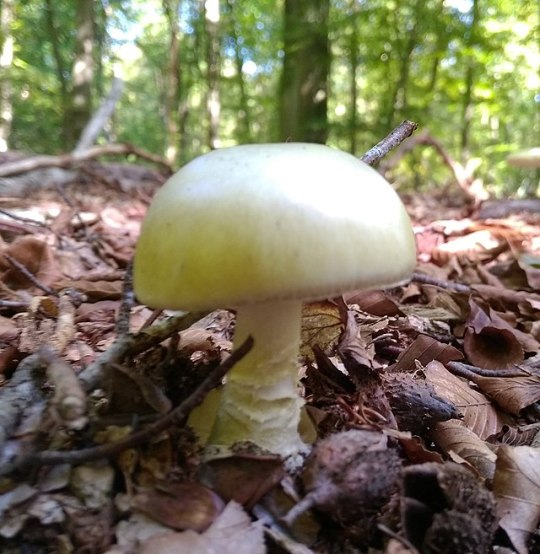
Okay, y'all, it's rant time again. Buckle up.
A new report just came out from Public Citizen highlighting the dangers of using apps and AI foraging guides for identifying mushrooms, particularly when mushroom foraging. It's the latest in a string of warnings that are fighting against a tide of purported convenience ("just take a picture and get your answer instantly!")
I've ranted about this since last August, and I also wrote up a detailed post on how to identify an AI-generated foraging guide. I'm also including info on the limitations of apps and AI in The Everyday Naturalist: How to Identify Animals, Plants, and Fungi Wherever You Go. I'm not just saying this to toot my own horn--it's because nature identification, and teaching it to others, is literally what I do for a living. So this is a topic near and dear to my heart.
I teach a very, very specific sort of identification class; whether we're focusing on animals, plants, fungi, or all of the above, I walk people through a detailed process of how to observe a given organism, make note of its various physical traits and habitat, and use that information to try to determine what it is. I emphasize the need to use as many sources as possible--field guides, websites, online and in-person groups, journal articles, etc.--to make absolutely sure that your identification is solid.
And every year, I get people (thankfully, a very small minority of my students) who complain because my two-hour basic mushroom hunting class wasn't just five minutes of introduction and one hundred and fifteen minutes of me showing slide after slide of edible mushrooms. There are so many people out there who just want a quick, easy answer so they can frolic in the woods and blithely pick mushrooms like some idealized image of a cottagecore herbalist with a cabin full of dried plants and smiling frogs or something.
While I do incorporate a bit of information on getting started with the app iNaturalist in my classes, it is as only ONE of MANY tools I encourage people to use. Sure, it's more solid than most apps because, in addition to the algorithmic I.D. suggestions it initially gives you, other iNaturalist users can go onto your observations later and either agree with your I.D.s or suggest something different and even explain why.
And yet--even as great as iNat is, it and its users can still be wrong. So can every other I.D. app out there. And I think that is one thing that the hyper-romanticized approaches to foraging--and nature identification in general--miss. In order to be a good forager, you HAVE to also be good at nature identification.
And nature identification is an entire process that requires you to have solid observational and critical thinking skills, to be able to independently research using many different types of tools, and be willing to invest the time, patience, and focus to properly arrive at a solid identification--if not to species level, then as far down the taxonomic ladder as you can realistically manage. (There's a reason even the experts complain about Little Brown Mushrooms and Damned Yellow Composites!)
People mistake one single tool--apps--for the entire toolkit. They assume any book they find on Amazon is going to be as good as any other, and don't take the time to look up the author to determine any credentials or experience, or even whether they actually exist or not. It doesn't help that the creators of these products often advertise them as "the only [book/app/etc.] you need to easily identify [organism of choice]!"
I mean, sure, the world isn't going to end if you never question the birdsong results on the Merlin app, or if you go through life thinking a deer fern is just a baby western sword fern. But when we get into people actually eating things they find in the wild, there's often no room for error. There are plants and mushrooms that can kill you even if you only eat a tiny amount. And even if they don't kill you, they may make you wish you were dead for a few days while you suffer through a whole host of gastrointestinal nastiness and other symptoms.
There aren't any shortcuts if you want to be safe in your foraging. You HAVE to be willing to do the work. And any teacher, author, or product that says otherwise isn't being ethical. I'm glad to see more people speaking out against the "fast foodization" of foraging in regards to overreliance on apps and the existence of AI foraging books; I just hope it's enough to prevent more people from getting sick or dying.
#long post#foraging#mushroom foraging#mushroom hunting#A.I.#apps#nature#ecology#environment#conservation#cottagecore#herbalism#nature identification#critical thinking skills#critical thinking#media literacy#mushrooms#fungi#fungus#shrooms
146 notes
·
View notes
Text




Fiddlehead Ferns 🌿
✨ Where to Find:
Moist, shaded areas in forests, near streams, and woodland edges.
✨ Identification:
Look for curled, green, fern tips resembling fiddles or spirals. Unfurl to reveal delicate, lacy fronds.
✨ Herbal & Medicinal Uses:
- Rich in antioxidants and vitamins (said to taste like asparagus and nuts)
- Supports digestive health
- Anti-inflammatory properties
- Used in traditional medicine for respiratory issues
✨ Wicca/Spiritual Meanings:
- Symbolize growth, renewal, and protection
- Represent connection to nature and cycles
- Assists with growth and transformation
✨ Magical Tips:
- Use in spells for abundance and prosperity
- Add to rituals for new beginnings
- Wear or carry in a charm bag for protection and guidance
Sadly, there isn’t any near me..Have any of you ever used them? Or eaten them?
-Earthy Mama 🌿
#fiddle sticks#fiddlehead#fern#plant#herbalism#charm bag#witchblr#witchcraft#baby witch#follow for follow#herbalism teacher#ask me#any requests?#nature#forest
13 notes
·
View notes
Text
Stately Sequoia Ch. 6
I am rampaging, folks. I might be busy for the rest of the weekend so I felt compelled to get all of these ideas out on paper before the plots get all jumbled or I forget and move on to a separate idea.
Thank you for all the support and comments. I literally read all of it and love hearing what you have to say!

You had avoided Larissa at all costs. The school year was off to a good start and you found out quite quickly the students were your favorite part of the job. Bianca and Wednesday were two stand out students in your advanced botany course. Eugene was a quiet student, but he certainly had a skill for plant identification.
Truthfully, you couldn’t stop thinking about Larissa however. Faculty meetings were the worst as you tried to remain focused on the task at hand, but Larissa was truly too beautiful to resist a glance or two.
You knew you were having to put effort into avoiding Principal Weems as she has sought out your company many times since your last date. You remember on one specific occasion she stopped by the greenhouse about two weeks after your parting.
“Fern. We really need to talk.” Larissa’s voice was gentle as she watched you seeding a batch of wildflowers for Eugene to keep for his bees.
“I really don’t think we do. What else is there to say?” You didn’t look up, you didn’t give her the satisfaction of even stopping what you were doing to speak to her.
You could feel Larissa behind you, inching closer, “I wanted to apologize.”
Your stubbornness was getting the best of you as you planted your hands against the table in front of you. You took a deep breath and still didn’t acknowledge her words.
Larissa closed the gap between you both by wrapping her arms around your middle, hugging you from behind. You felt her warm lips against your neck, involuntarily you tilt your head to the side, granting her more access to you.
Much to your dismay, she unraveled her arms and left you longing for her warmth.
———-
A month into the semester and it was finally Parents Weekend. Before the arrival of parents, there was a brief meeting among teachers. You listened to Larissa’s instructions while listening to Rowan’s smart ass comments on the side.
“Parents weekend can’t get over soon enough,” Rowan huffed as you both made your way towards the quad. Student’s of hers quickly call her over to make introductions between their favorite vampire professor and their parents. You remained near a pillar, observing the interactions between your beloved students and their family members. A familiar presence appeared at your side, towering over you.
You had been considering re-initiating your relationship with Larissa, but after your behavior weeks ago, you found it hard to believe Larissa would want anything to do with you. Now, your relationship seemed to have returned to strictly professional.
“Lovely, isn’t it?” Larissa asked looking out across the sea of students and guardians.
You stared up at your principal, eyes not leaving her face as you respond, “Yes... Lovely.”
Larissa met your gaze, that beautiful smirk gracing her red lips once again. You stood there for a moment watching each other before you were brutally interrupted.
“Larissa!” A dark haired beauty approached the principal with open arms. More importantly, you saw Weems’s face fall before she forced a smile. The approaching parent wore a tight fitting black dress and was accompanied by a Latin man. Peaking around them, the annoyed face of Wednesday Addams followed after them.
“Morticia. How lovely to see you.” Larissa accepted the embrace and you took that as your sign to mingle with the other parents present.
————
“You must be the botany professor my daughter speaks so highly of.”
You were on your hands and knees digging in the conservatory to plant a sequoia tree of your own. You had been inspired recently and had a small sapling shipped from the west coast.
You sit back on your feet and glance up at Morticia Addams, who had now graced your conservatory. From observing her earlier this morning, she seems to have a natural flirtation about her.
“Good afternoon, Mrs. Addams. I’m Dr. Rogers.” You decided to keep the introduction as formal as possible due to Larissa’s seemingly negative reaction to seeing her old roommate.
“Oh, please, you can call me Morticia.” She took another step towards you, causing you to have to crane your neck even higher to look at her. You were sure this was some kind of power move.
“Is there anything I can help you with, Morticia?” You faked a smile before turning back to your sapling at hand.
“Oh… No… Just touring around… Larissa speaks very highly of you...” She glanced upwards and around at the different trees, vines, and shrubs you had cultivated. Morticia drew a hand innocently across your back as she stepped behind you and moved onward to explore your greenhouse.
“I’m glad to hear she is pleased with my performance. I enjoy my work here.”
“Oh, yes... You know, she used to enjoy my performance as well. I was just thinking-” Morticia began a story that you weren’t quite sure if you wanted to hear. From Rowan’s stories, it was revealed to you that Principle Weems and Morticia Addams were once romantically entangled.
“Morticia.” A stern voice barked from the entrance to the greenhouse. Larissa loomed in the doorway, “It seems Gomez is looking for you. Perhaps you should go check on him. Separation anxiety, I assume.”
Larissa’s dig caused your eyes to widen and Morticia’s jaw clenched in response. There was a tension here between these women and with both of their dominating demeanor, you would rather stay out of it.
“Don’t worry, Fern. We can continue this conversation at a later date. I’m sure you would love to hear the rest,” Morticia’s words seemed to be directed at Larissa as she took her exit.
Rather than question the intensity of Morticia and Larissa’s interaction, you turned your head back the the small tree. Once a hole was large enough for the roots, you gently inserted the small tree.
Larissa couldn’t help herself as she found her way to your side, kneeling next to you, “What are you doing?”
Her tone had been so soft with you since your miscommunication. You glanced up at her and gestured down to the plant, “It’s a sequoia tree. I’ve never grown one before…”
Larissa watched as you leveled out the soil, gently packing it down so the little tree stands upright. She hums in approval, watching your movements.
“Would you like to try?” You ask, tilting the watering can over, thoroughly watering it in.
“Try what?”
You hold out your hand, requesting hers in return. Obeying, she offers up her gloved hand. You absentmindedly smile, gently pulling at the fingertips of the glove so you can slide it off, laying it off to the side.
You push her palm down into the soil, laying both of yours on top. That familiar warmth travels from your chest and down your arms to your fingers. Larissa gasps as she feels the energy travel through her hand, down into the soil. In return, the sapling began to shift, its roots taking hold and the branches began to spread and its trunk expanding.
You held Larissa there until the few inch sapling grew to nearly four feet tall, not wanting it too big.
“Beautiful.” Larissa whispered still mesmerized by the sight of the tree in front of her.
You turn your head to make eye contact, once again mesmerized by Weems beauty, “Yes, beautiful…”
In an instant you collided with one another, Larissa couldn’t help herself any longer. Her gloved hand and dirt covered hand pressed to the sides of your face as she covered your lips with hers. You felt desperate for her. Her strong arms had you swept up in an instant. Her dirty hand remained on your face, while the other guided you into her lap. You were happy to oblige.
Now straddling her lap, the intensity of the kiss built. Your mouth opened at the probing of her tongue, your own arms wrapping around Larissa’s neck. She caught your lip between her teeth causing you to let out a soft moan before diving back in.
You continued like this, making out until you finally pulled away, her lips seemed to chase yours for a moment until she realized you needed a breather. Larissa stifled a laugh, brushing your face with her gloved hand to remove the muddy smudge that now graced your cheek, “This seems to be a trend between you and I.”
Link to Chapter 7
298 notes
·
View notes
Text
Blog 1: Evolution and Development of my Relationship with nature
Hey everyone! I attend the University of Guelph as a 4th year Marine and Freshwater student. I want to welcome everyone to my blog! This is my first blog post and I will be talking about the relationship I share with nature and how it continues to develop.
I have always felt I have had a strong connection with nature, especially with anything that relates to the water (mainly fish, but also many of the different animals). This largely stems from being at my cottage located in Tobermory, Ontario. My father would bring us down to the water and teach us where to look for crayfish and how to catch them. For many years we would beg to make the 3 hour journey just to spend the majority of the time lifting the rocks along the shoreline and capturing crayfish to see the different sizes we could find, and then safely release them after playing with them. This is what I believe what began an ever expanding interest in aquatic animals.
This experience with my family at my cottage created an extremely special place for me. So much so that during the summer I live there full-time and work for Parks Canada, to help keep the area as perfect and as special for others as it has been and always will be for me. By being in one of my favorite places for approximately half the year I began to look more closely at everything around, which opened how I see not only the forests, marshes, and beaches in that area but of all places that I travel to.
Over this last summer I began to dabble in a bit of mycology. I began to notice how important even the most insignificant looking plant, fungus, or animal truly is and what kind of role they may play. A friend of mine from Parks Canada who is a mycology masters student at the University of Guelph is helping me develop a deeper relationship with all the different fungi in the area and helping me with my identification skills of the main mushrooms and fungi groups of not just the area but of a more broad and general identification. This past summer my relationship with nature has expanded and evolved/ developed in ways I never would have thought about. I began looking closer at the formation of rocks and how indigenous peoples may have used the different caves around the islands or the ones on the mainland. For example, there is one cave on an island in the Fathom Five National Marine Park called Butter cave that before fridges were invented the lighthouse keepers on the island and indigenous peoples used to keep their food cold. There is a different cave on the mainland that is named fern cave, and it intrigues me a lot because during only a certain time in the summer the cave is filled with beautiful ferns, but looking at the shape and formation of the cave it seems as if it would have been a perfect location to use for shelter. I always try to think of who might have used this and I will go into the cave to see if there’s any cave drawings or any evidence someone from the past lived there (it isn’t that big but still big enough you can’t touch the ceiling).
I could go on and on about tobermory and how much I love it and anytime I'm there it feels like I belong and it gives me a "sense of place". Please come back again for my next blog post and continue this journey through nature with me! Enjoy these pictures I have taken from various locations around tobermory and if you have any questions about them ask away!
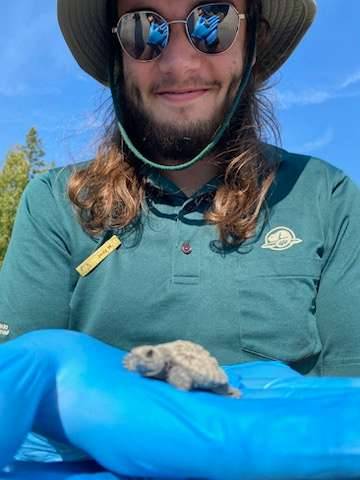
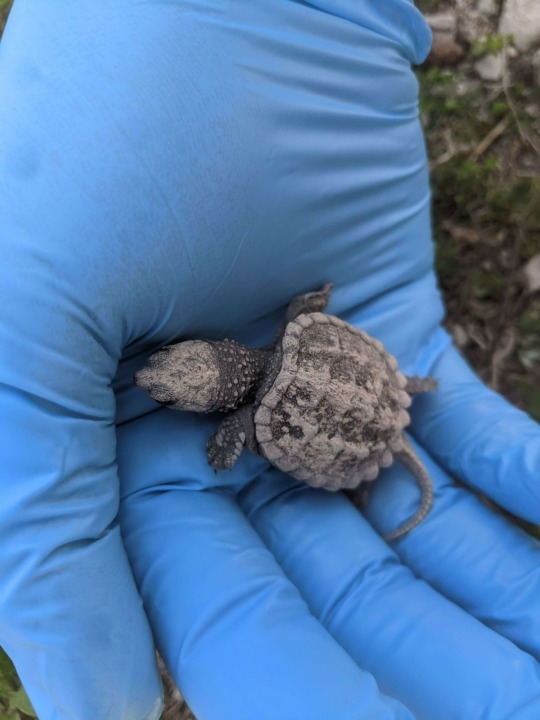

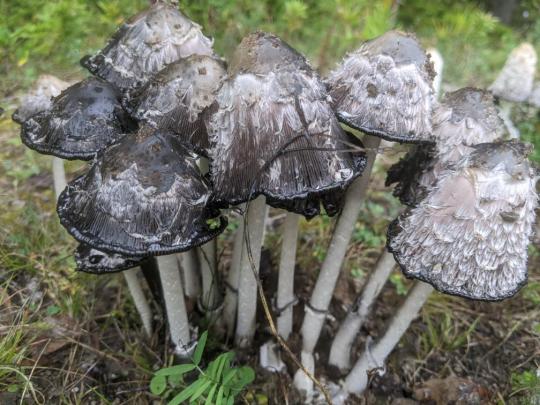
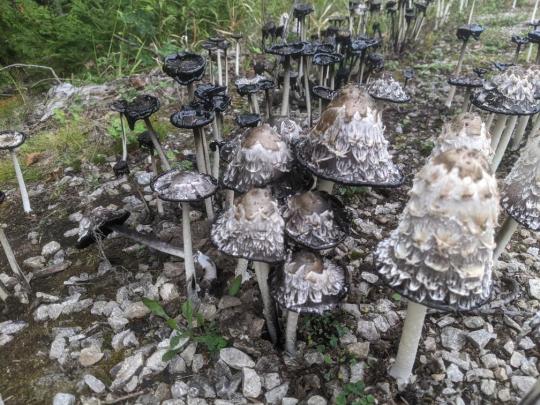
11 notes
·
View notes
Video
n9_w1150 by Biodiversity Heritage Library Via Flickr: The book of choice ferns for the garden, conservatory, and stove London :L. Upcott Gill,1892-1894 biodiversitylibrary.org/page/42773417
#Ferns#Identification#Smithsonian Libraries#bhl:page=42773417#dc:identifier=https://biodiversitylibrary.org/page/42773417#flickr#fern#blechnum linnaeus#Blechnum#hard fern#botanical illutration#scientific illustration
1 note
·
View note